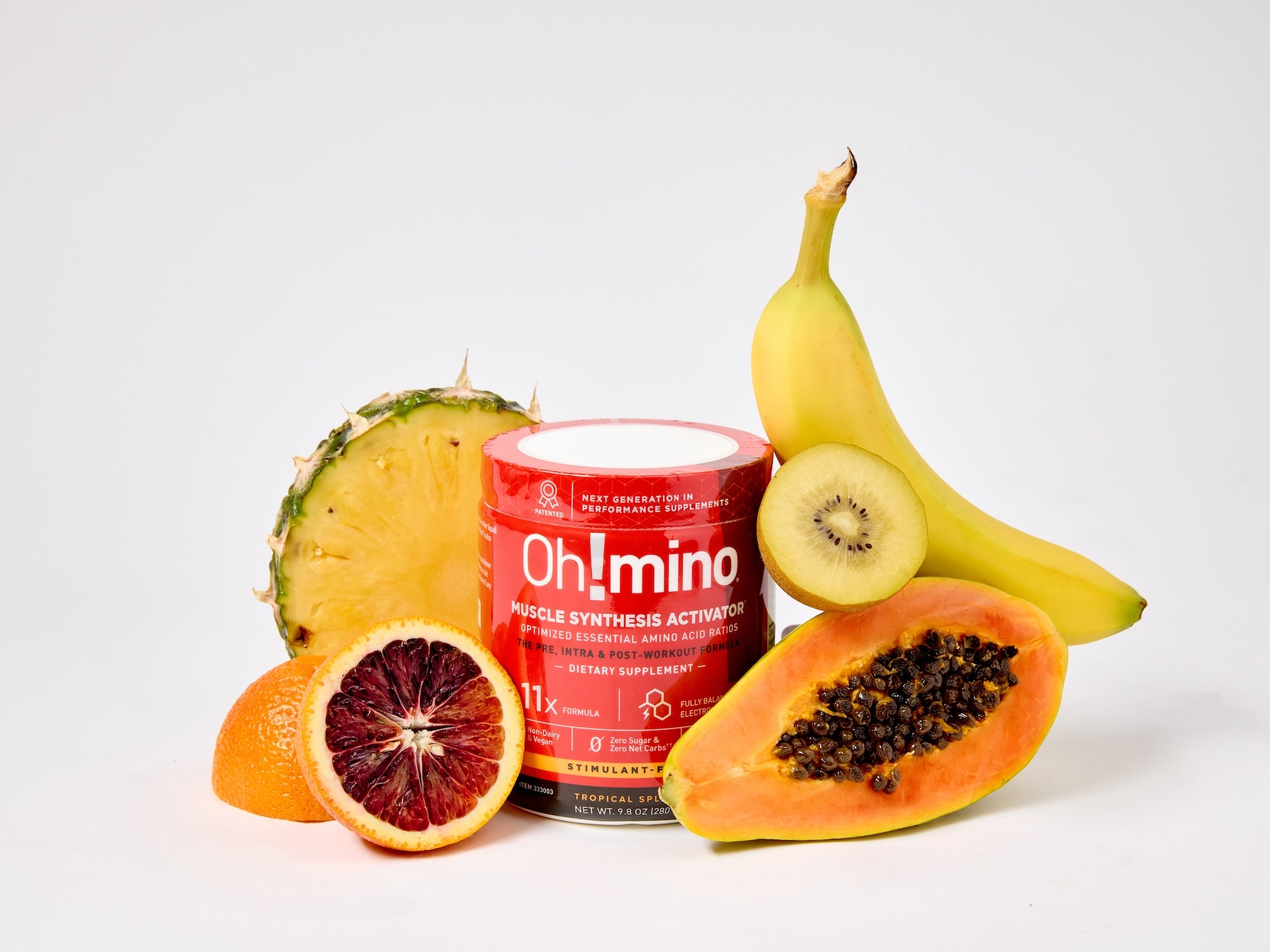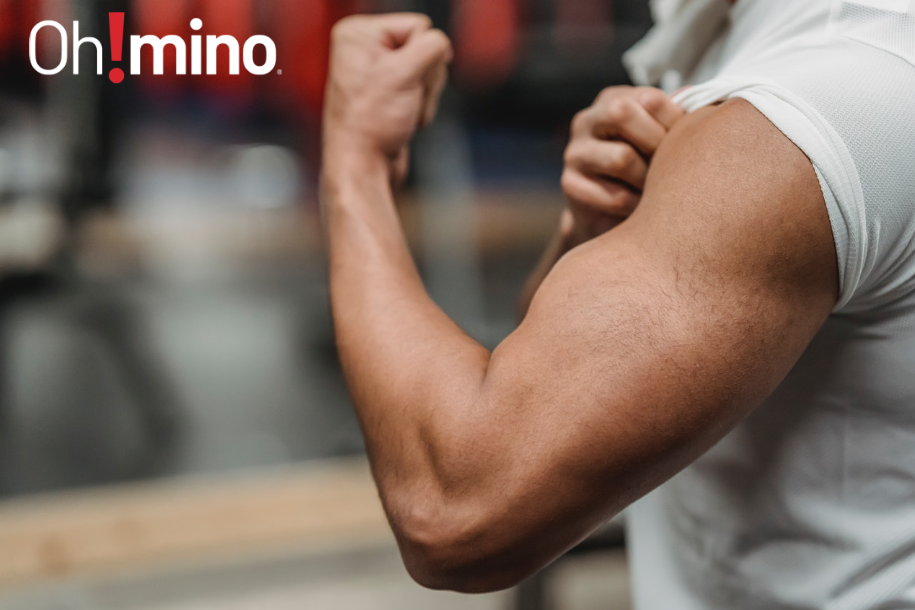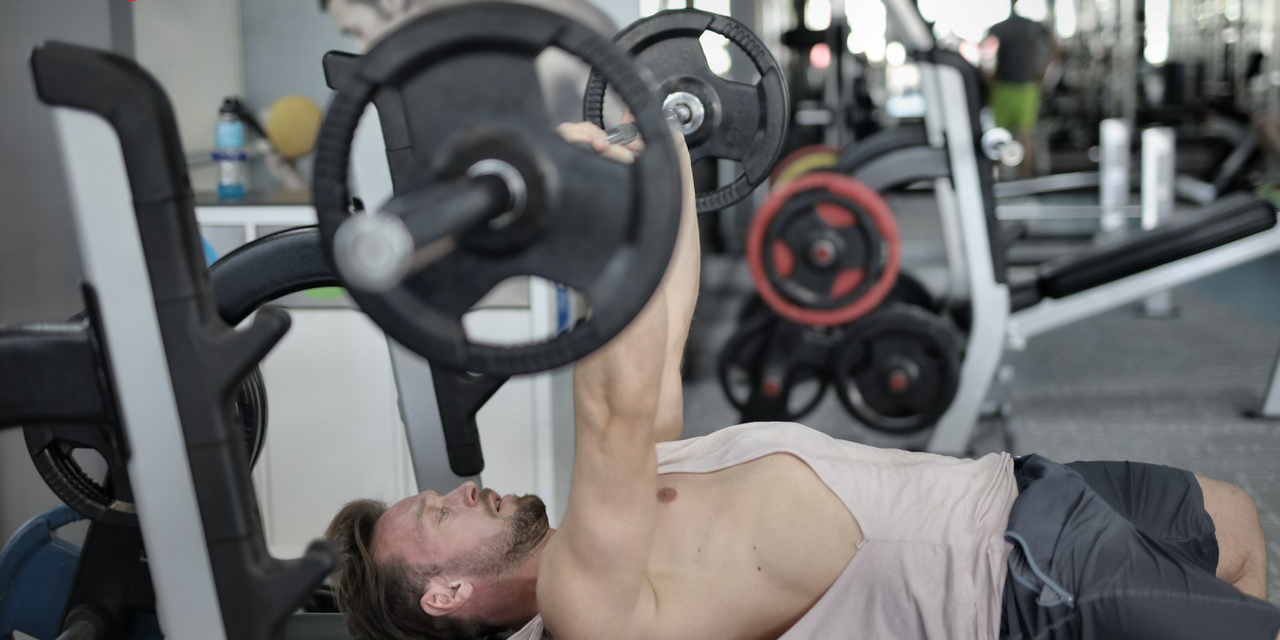Key Takeaways
-
Two distinct types of muscle growth serve different purposes. Myofibrillar hypertrophy increases contractile proteins for strength and power, while sarcoplasmic hypertrophy expands muscle volume through increased fluid and energy storage capacity.
-
Heavy loads with low reps (1–5) primarily stimulate myofibrillar growth, while moderate loads with higher reps (6–20) favor sarcoplasmic expansion, though both occur simultaneously to varying degrees.
-
Myofibrillar growth requires higher protein intake for contractile protein synthesis, while sarcoplasmic growth benefits from increased carbohydrate intake to support enhanced glycogen storage.
-
The most well-rounded physiques and performance profiles come from incorporating both training styles, allowing for maximum strength development alongside impressive muscle size and definition.
-
Oh!mino® Muscle Synthesis Activator provides all nine essential amino acids, including the crucial BCAAs in scientifically optimized ratios, delivering effective muscle protein synthesis and supporting both myofibrillar and sarcoplasmic adaptations regardless of your training approach.
Understanding the Science Behind Muscle Development
Becoming bigger, stronger, and better-looking are the major reasons many of us began weight training. And while lifting may seem pretty straightforward, how your muscles grow (and look) depends on which hypertrophy you are training for.
Generally speaking, there are two of them:
-
Myofibrillar hypertrophy
-
Sarcoplasmic hypertrophy
Myofibrillar hypertrophy is the increase in the size of the muscle contractile units, called 'myofibrils' and commonly known as "muscle fibers". These muscle fibers are the contractile elements of the trained muscle groups, which allow contraction and relaxation.
Sarcoplasmic hypertrophy, on the other hand, is the growth of the 'sarcoplasm', which is basically a jelly-like fluid that surrounds the muscle fibers. The sarcoplasm contains different non-contractile elements, which can grow in volume, depending on the type of training.
It is believed that the myofibrils are more closely related to the maximum output of strength and explosiveness, while the sarcoplasm is engaged during intense, yet longer loads.
In other words, myofibrillar hypertrophy is a result of a powerlifting approach to weight training, where you do 1–5 repetitions. Oppositely, sarcoplasmic hypertrophy is a result of a bodybuilding approach to training, where you do 6–15+ repetitions with heavy weights.
|
Oh!mino©: Elevate Your Performance. Accelerate Your Recovery. Science-Backed Superiority for Every Fitness Journey Power Your Goals with Proven Results:
The Oh!mino® Advantage: ✓ Patented formula that’s 11x more effective than protein, 20x more effective than BCAAs Choose Your Perfect Formula: Available in refreshing Tropical Slash or Berry Blast flavors, with stimulant-free or caffeinated options. Prefer capsules? We've got you covered with the same powerful formula. Take before, during, or after training—one solution for your entire workout. |
The Physiological Mechanisms Behind Each Type

The bodybuilder on the left trains primarily for sarcoplasmic hypertrophy, while the sprinter on the left trains solely for myofibrillar hypertrophy.
Myofibrillar Hypertrophy: Building Functional Strength
Myofibrillar hypertrophy occurs when the actual contractile proteins within muscle fibers increase in size and number. This type of growth primarily involves the synthesis of actin and myosin filaments—the proteins responsible for muscle contraction. When you lift heavy weights for low repetitions, you create mechanical tension that signals your body to build more contractile proteins.
This process is accompanied by increased mitochondrial density and improved neural adaptations. The result is muscles that look denser and actually perform better in terms of absolute strength and power output. Athletes who prioritize this type of hypertrophy typically exhibit superior strength-to-size ratios.
Sarcoplasmic Hypertrophy: Maximizing Muscle Volume
Sarcoplasmic hypertrophy focuses on increasing the volume of the sarcoplasm – the fluid-filled space between muscle fibers. This fluid contains glycogen, water, minerals, and various other non-contractile elements. When you perform higher-repetition training with moderate to heavy weights, you create metabolic stress that encourages the muscle to store more glycogen and water.
This type of growth creates the "pumped" appearance many bodybuilders seek. The muscles appear fuller and more voluminous, though the actual increase in contractile proteins may be proportionally smaller compared to myofibrillar hypertrophy. This explains why some very large bodybuilders may not be as strong as smaller powerlifters or strength athletes.
Training Protocols for Optimal Hypertrophy Results

Different training variables influence which type of hypertrophy your muscles will primarily adapt to, though note that both types typically occur simultaneously to some degree.
Myofibrillar-Focused Training Protocols
Heavy Load Training (1–5 Reps)
Training in the 1–5 repetition range with 85–100% of your one-rep max primarily stimulates myofibrillar growth. This approach maximizes mechanical tension, which is the primary driver of contractile protein synthesis. Rest periods should be longer (3–5 minutes) to allow for full muscle recovery between sets.
Compound Movement Emphasis
Multi-joint exercises like squats, deadlifts, bench press, and pull-ups should form the foundation of myofibrillar-focused training. These movements allow for the heaviest loads and create the greatest mechanical tension across multiple muscle groups simultaneously.
Progressive Overload Priority
Consistent increases in weight, even if small, are crucial for continued myofibrillar adaptation. This might mean adding just 2.5 pounds to a lift every week or two, but the progression must be consistent and measurable.
Sarcoplasmic-Focused Training Protocols
Moderate to High Rep Training (6–20 Reps)
Training in higher repetition ranges with 65–85% of your one-rep max creates the metabolic stress necessary for sarcoplasmic growth. This approach increases muscle glycogen storage capacity and enhances the muscle's ability to buffer metabolic byproducts.
Shorter Rest Periods
Rest periods of 30–90 seconds between sets maintain the metabolic stress that drives sarcoplasmic adaptations. This shorter recovery time keeps the muscle in a state of partial fatigue, encouraging adaptations in energy storage and waste removal systems.
Volume and Frequency Focus
Higher training volumes (more sets and exercises per muscle group) and increased training frequency (hitting each muscle group 2–3 times per week) optimize the conditions for sarcoplasmic growth.
Nutrition & Recovery Considerations for Muscle Growth

The type of hypertrophy you're training for also influences your nutritional and recovery strategies, as each places different demands on your body's systems.
Nutritional Strategies for Myofibrillar Growth
Myofibrillar hypertrophy requires adequate protein intake to support the synthesis of contractile proteins. Some fitness professionals suggest consuming 1.6–2.2 grams of protein per kilogram of body weight daily, with particular attention to leucine-rich sources that maximally stimulate muscle protein synthesis.
Carbohydrate intake can be more flexible for myofibrillar-focused training, as the lower training volumes don't deplete muscle glycogen to the same extent as higher-volume protocols. However, sufficient carbohydrates around training sessions help maintain performance and support recovery.
Nutritional Strategies for Sarcoplasmic Growth
Sarcoplasmic hypertrophy benefits from higher carbohydrate intake to support the increased glycogen storage capacity that develops with this type of training. Consuming 3–7 grams of carbohydrates per kilogram of body weight helps maximize muscle fullness and supports the high training volumes typical of bodybuilding-style programs.
Hydration becomes particularly important for sarcoplasmic growth, as the increased fluid retention within muscles requires adequate water intake. The "pump" that many bodybuilders chase is essentially temporary sarcoplasmic expansion, and chronic dehydration can limit this adaptation.
Recovery Protocols for Both Types
Sleep remains crucial regardless of training style, with 7–9 hours per night supporting optimal recovery and growth hormone release. However, myofibrillar-focused training may require longer recovery periods between sessions (48–72 hours for the same muscle groups), while sarcoplasmic-focused training often allows for more frequent training of the same muscles.
Which One Should You Train For?
Ultimately, there's no right or wrong answer. You should train for whatever aligns with your fitness goals. But don't completely neglect one type of training for another.
Try to stimulate both types of muscle growth and other functions like balance, agility, and coordination. Become a functional human being.
Oh!mino®'s Blueprint: Fueling Complete Muscle Development
At Oh!mino®, we recognize that true muscle development isn't about choosing between size and strength—it is optimizing both. Our Muscle Synthesis Activator was specifically formulated to support the complete spectrum of muscle growth, whether you're chasing powerlifting PRs or bodybuilding stage presence.

Stay fit my friend. Gain strength, build muscle, and recover faster with Oh!mino.
The science is clear: complete muscle development requires complete nutrition. While traditional supplements might favor one type of adaptation over another, our patented blend of all nine essential amino acids (L-Leucine, L-Lysine, L-Threonine, L-Valine, L-Phenylalanine, L-Histidine, L-Isoleucine, L-Tryptophan, and L-Methionine), including the crucial BCAAs, balanced electrolytes, and powerful adaptogens ensures your muscles have everything they need for both myofibrillar and sarcoplasmic growth.
We've spent years perfecting our formula because we understand that your goals shouldn't be limited by your supplementation. Whether you're building dense, functional muscle or pursuing that coveted pump and fullness, Oh!mino® provides the nutritional foundation for success. After all, why settle for half the potential when you can unlock complete muscle development?
Try Oh!mino® Muscle Synthesis Activator Today!
Frequently Asked Questions (FAQs)
Can I train for both types of hypertrophy simultaneously?
Yes, and this is often recommended for most trainees. You can incorporate both heavy, low-rep training and moderate-to-high rep training within the same program.
For example, you might start your workout with heavy compound movements in the 1–5 rep range, then finish with higher-rep accessory work in the 8–15 rep range.
How long does it take to see results from each type of training?
Myofibrillar adaptations typically become noticeable after 4–6 weeks of consistent training, with strength gains often preceding visible size increases.
Sarcoplasmic adaptations can be seen more quickly, sometimes within 2–3 weeks, as increased muscle fullness and pump become apparent. However, significant visual changes usually require 8–12 weeks of consistent training.
Do genetics play a role in which type of hypertrophy I respond to better?
Absolutely. Individual muscle fiber type distribution significantly influences your response to different training styles.
People with more fast-twitch (Type II) fibers often respond better to power and strength training that promotes myofibrillar growth, while those with more slow-twitch (Type I) fibers may see better results from higher-volume training that encourages sarcoplasmic adaptations.
Is one type of hypertrophy better for fat loss?
Myofibrillar hypertrophy may have a slight edge for fat loss due to the higher metabolic cost of maintaining contractile proteins and the increased strength that allows for more challenging workouts.
However, sarcoplasmic-focused training often involves higher training volumes, which can increase total energy expenditure. The most effective approach for fat loss combines both training styles with appropriate nutrition.
How does Oh!mino® support both types of muscle growth?
Oh!mino® Muscle Synthesis Activator contains all nine essential amino acids in optimal ratios, including the crucial BCAAs. They provide the building blocks necessary for both contractile protein synthesis (myofibrillar growth) and supporting the cellular machinery involved in sarcoplasmic expansion.
The balanced electrolytes help maintain proper cellular hydration for sarcoplasmic adaptations, while the complete amino acid profile ensures maximum muscle protein synthesis regardless of your training focus.





